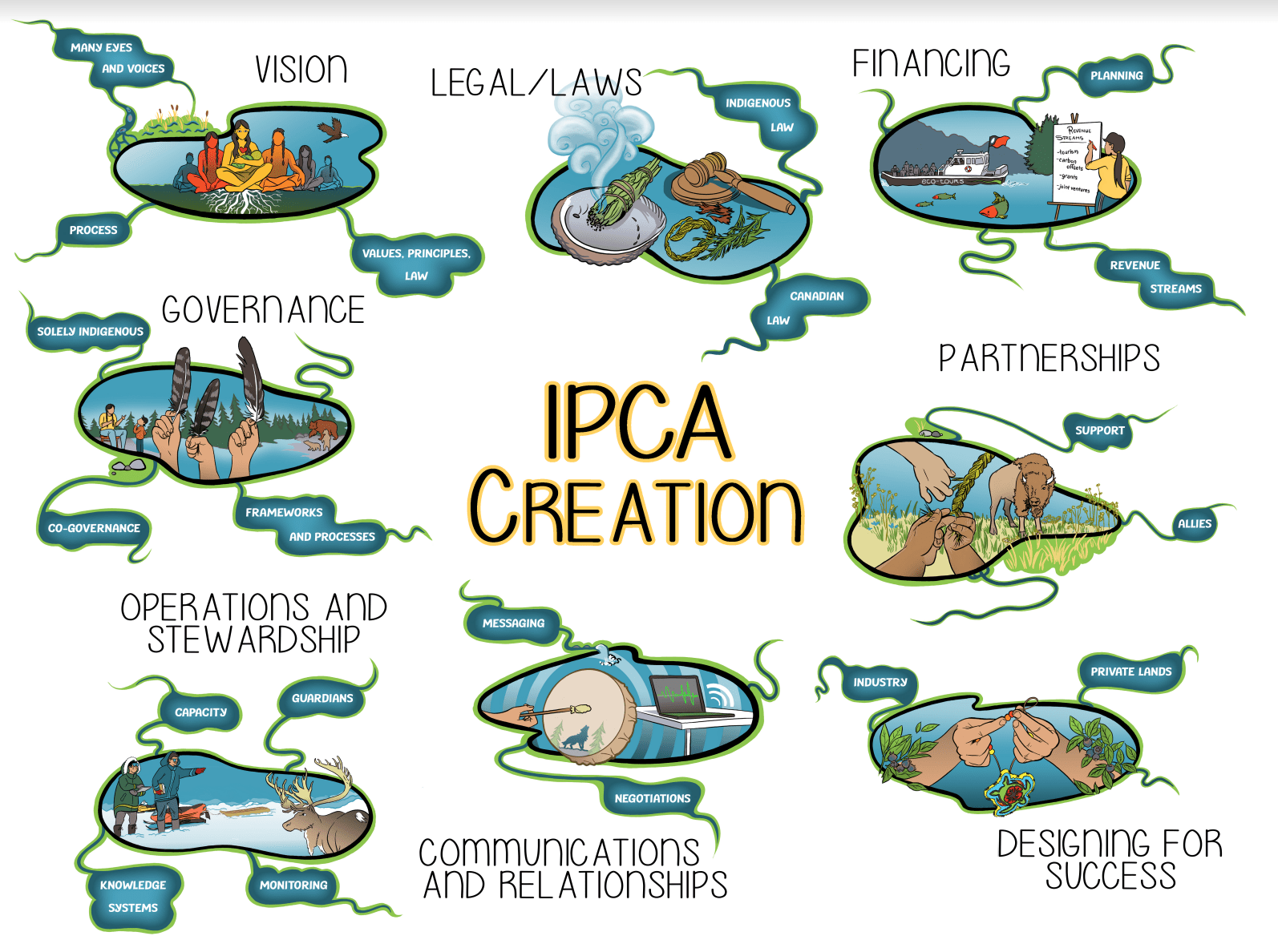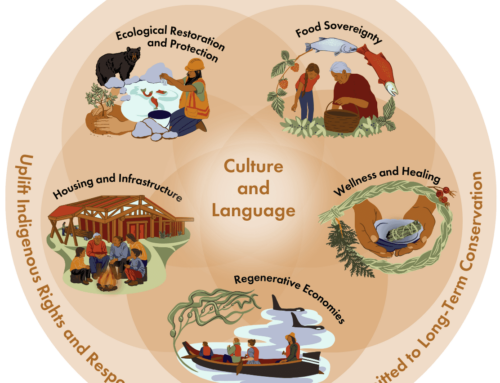IPCA Creation Guide

IPCA Creation Guide by Conservation through Reconciliation Partnership is licensed under a Creative Commons Attribution-NonCommercial-ShareAlike 4.0 International License.
Publication Date: June 2022
What are IPCAs?
Indigenous Nations and communities lead the creation of Indigenous Protected and Conserved Areas or “IPCAs,” This is what makes IPCAs so unique. IPCAs vary from territory to territory and nation to nation. Yet, they share features like ecological conservation and elevating Indigenous rights and responsibilities.
By creating IPCAs, Indigenous Peoples’ strengthen their relationships to their lands and waters. Indigenous Nations and communities establish IPCAs for many reasons. Some of these reasons include to:
- share their vision for their lands, waters, and communities
- attract resources and build capacity to bring that vision to life
- gain support from partners and Crown governments
- support decision-making about lands, waters, and communities
- protect important species and places
- strengthen Indigenous cultures, knowledge systems, languages, laws, and traditions
- promote intergenerational learning
- support local economies, and community health and well-being
- uphold responsibilities to lands and waters for future generations.
In 2018, the Indigenous Circle of Experts (ICE) published an important report on IPCAs. The report is called “We Rise Together.” ICE included insights shared by the Indigenous Peoples they spoke to across the country. In their report, ICE made 28 recommendations to support Indigenous-led conservation and reconciliation. The recommendations are mainly for Crown (federal, provincial, and territorial) governments.
The Conservation through Reconciliation Partnership (CRP) developed this guide to support Indigenous Nations (First Nations, Métis, Inuit) to establish Indigenous Protected and Conserved Areas (IPCAs). We included questions and examples to assist your visioning and planning, but not tell you what to do. We included some examples that are not specific to IPCAs but that might be helpful. This includes insights from the lived experiences of Indigenous Peoples. The lead author was Justine Townsend. The artwork is from Nicole Marie Burton. We are grateful to the contributors who made this guide possible.
This guide is evergreen and will be refreshed and revisited annually.
IPCA Creation Guide
Vision
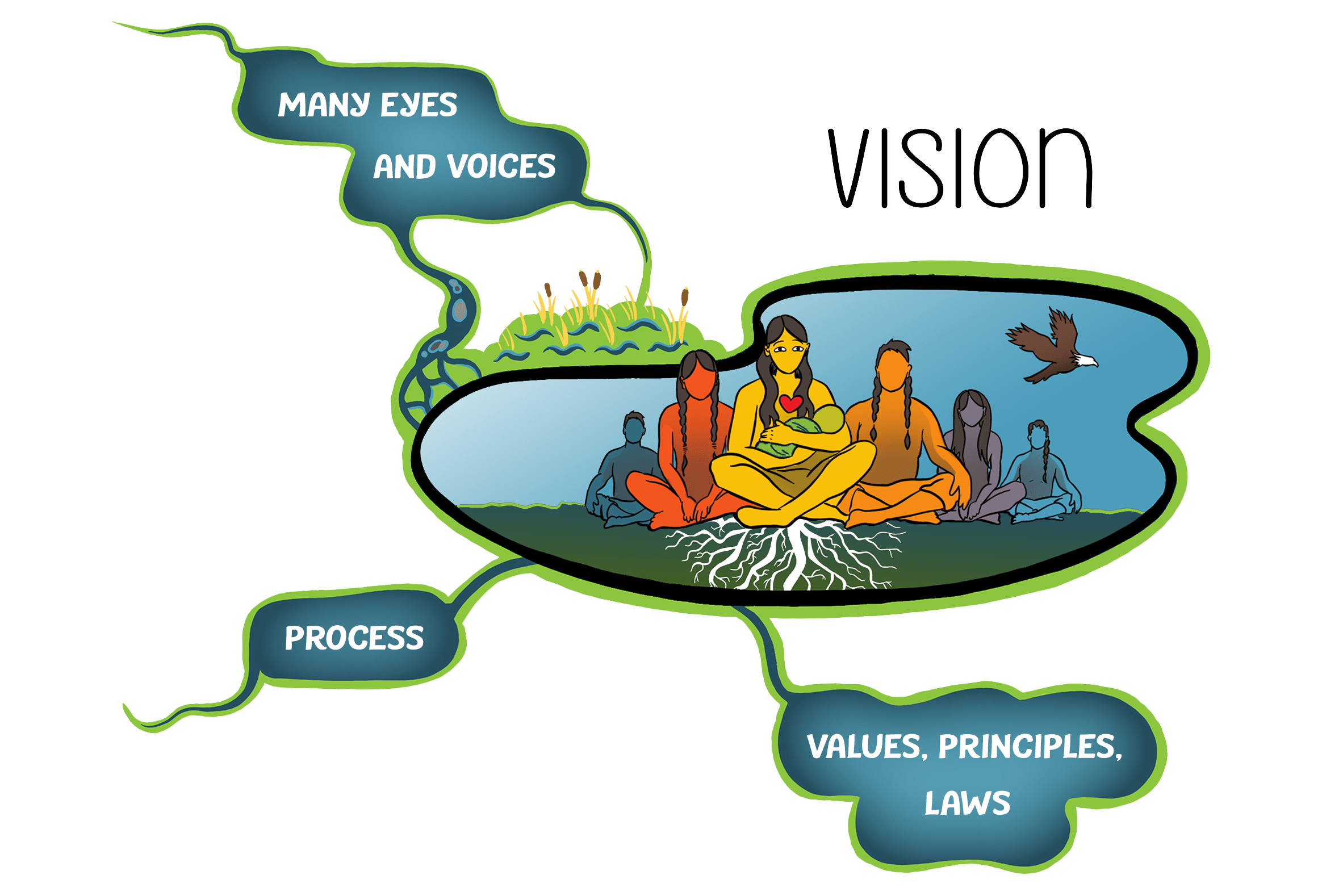
Many Eyes & Voices
How can the visioning process for the IPCA include many voices?
- Who needs to be involved so that the vision represents the voices and direction of the community(ies)? (E.g. leaders, elders, families, youth, community members, etc.)
- Which additional groups, communities, Nations could it be beneficial to include? (E.g. Elders, youth, and women’s groups; on and off reserve; LGBTQ+2S; neighbouring communities; important partners; etc.
- Example: Lutsel K’e Dene First Nation’s (Akaitcho territory/NWT) negotiation team held multiple information sessions about the draft Establishment Agreements for Thaidene Nëné (i.e. the terms of establishment negotiated with federal and territorial government partners). The Nation conducted a community referendum before proceeding with establishment. See the “third law” here.
- Example: Dasiqox Nexwagwez?an Tribal Park initiative (Tŝilhqot’in territory/B.C.) conducted extensive community engagement which informed the goals and vision.
Resource: See Dasiqox Nexwagwez?an’s “Community Vision and Management Goals” and “Public Engagement Summary Report” here.
What is the process for determining which areas, places, and/or species need protection or restoration? (E.g. land use planning, community visioning, community engagement, input from Indigenous Guardians, Indigenous knowledge, etc.)
Resource: Unama’ki Institute of Natural Resources’ (2020) report “Tan Telolti’k: How we are doing now” initiates management planning and informs a decision-making framework for IPCAs in Unama’ki (Mi’kmaw, NS).
Process
How will the vision be created?
- What has worked well in the past when engaging community members and leaders?
- Are there specific community protocols or processes that should be followed?
- How can community participation be maximized? (E.g. language/translation, written vs. oral communications, accessibility of meetings/locations, honoraria and reciprocity for participation, aligning with other gatherings, etc.)
- How can the community process and facilitation be trauma-informed? (E.g. design the process to avoid (re)traumatizing participants)
Values, Principles, Laws
- What values, principles, or laws will be expressed through the IPCA?
- Resource: Tribal Parks and IPCAs: Lessons Learned from B.C. Examples (2018) Report by David Suzuki Foundation
- Resource: Tribal Parks and IPCAs: Lessons Learned from B.C. Examples (2018) Report by David Suzuki Foundation
- What are the short- and long-term goals?
- Are there other initiatives that can support this vision and that the IPCA can support in return? (E.g. planning processes, nearby protected areas and conservation initiatives, Indigenous Guardians, negotiations with Crown or industry, other environmental or cultural initiatives, etc.)?
- Resource: Land relations planning and IPCAs webinar hosted by the CRP (2020)
- Examples of vision statements:
- Bistcho Lake IPCA vision statement (Dene Tha’ First Nation, AB)
- Seal River Watershed Initiative vision statement (Sayisi Dene First Nation in partnership with Cree, Dene and Inuit neighbours, MB)
- Atikamekw Nehirowisiw’s vision statement for their IPCA (famille Coocoo de Wemotaci, Conseil de la Nation Atikamekw, Conseil des Atikamekw de Wemotaci, Quebec)
- Unama’ki Institute of Natural Resources’ (2020) report “Tan Telolti’k: How we are doing now” includes a vision statement (pg. 5)
- Are there culturally important or sensitive areas, places, habitats and/or species that need protection or restoration? (E.g. sacred or historical sites, harvesting areas, etc.)
-
- Example: Uapashkuss (Innu organization, Quebec) is protecting eight Innu natural sacred sites.
-
- Which relationships need to be nurtured to achieve the protection, conservation, and restoration goals? (E.g. human relationships, ecological relationships, cultural relationships, intergovernmental relationships)
- What is important to the community(ies) and how can this be enhanced? (E.g. health, economic development, language, ceremony, country foods, intergenerational sharing, governance, etc.)
- Does access to important places need to be enhanced, restored, protected, or closed? (E.g. trails, roads, waterways, closures, etc.)
- Which areas are important for upholding or demonstrating jurisdiction? (E.g. for the negotiation of treaties, rights recognition agreements, Aboriginal and treaty rights cases)
Legal/Laws
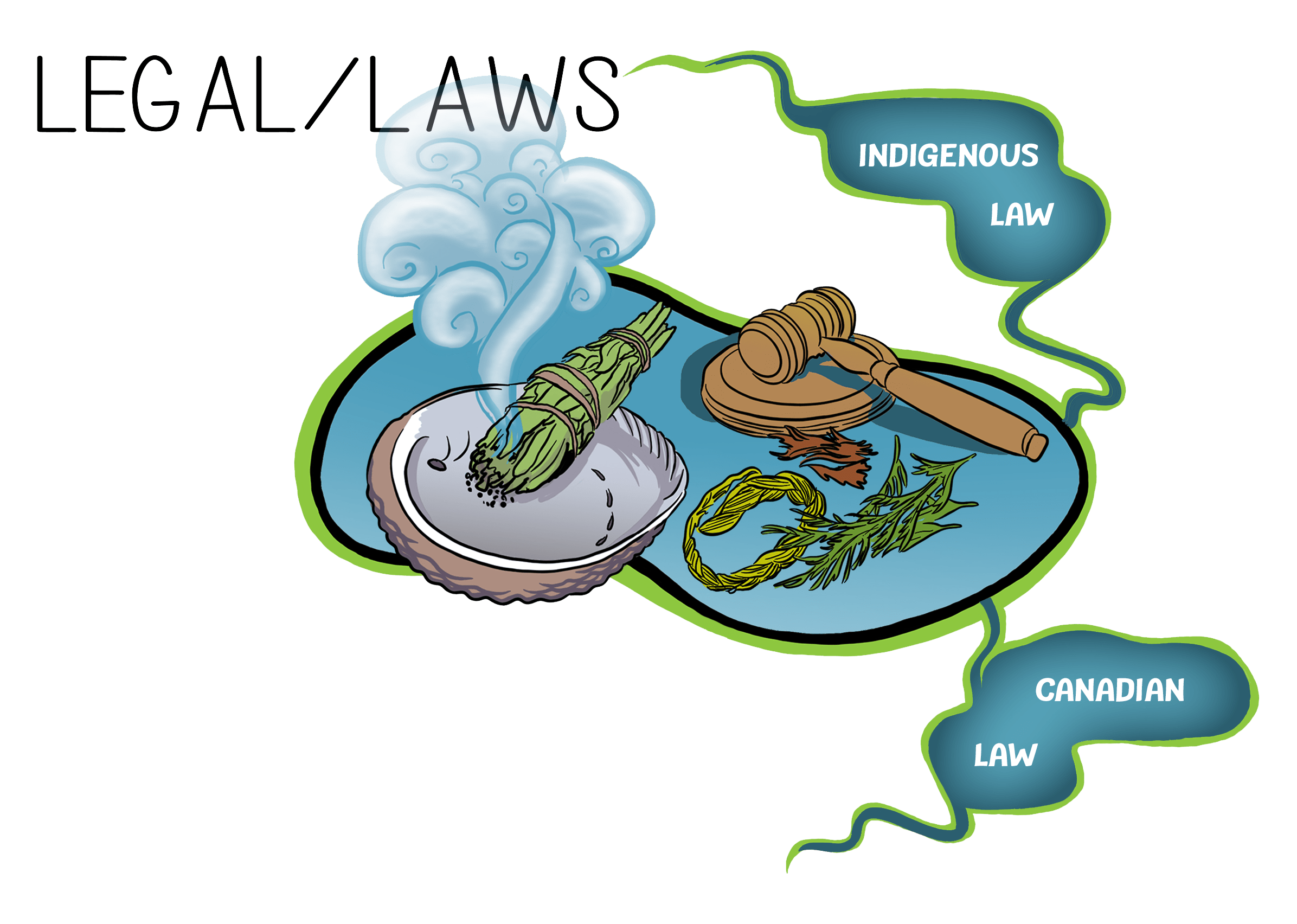
Indigenous Law
- How will Indigenous/traditional laws, structures, and processes be reflected in the establishment and implementation of your IPCA?
- What work do you need to do to revitalize your laws? What resources can you draw upon to understand your laws (e.g. stories, language, land, elders, songs, ceremonies etc.)?
- If you ground your IPCA in Indigenous laws, do you want to communicate this to external parties? If so, how? What do you feel comfortable sharing?
- Example: Lutsel K’e Dene First Nation first established Thaidene Nëné (NWT) as an IPCA using Dene legal orders.
- Example: The Council of the Haida Nation first established Gwaii Haanas National Park Reserve, Haida Heritage Site, and National Marine Conservation Area (B.C.) under Haida law.
- Example: The Tŝilhqot’in Nation (B.C.) enacted several of their own laws and policies related to stewardship, wildlife, and hunting. See “Laws” here.
- Example: Ashnola IPCA April 28, 2022
Canadian Law
- Will you pursue additional legal protection using federal/provincial/territorial legislation or other laws or agreements? (E.g. international, national, provincial/territorial, municipal)
- Example: The Council of the Haida Nation and Parks Canada co-govern Gwaii Haanas National Park Reserve, National Marine Conservation Area, and Haida Heritage Site (B.C.). The Archipelago Management Board, made up of Haida and Parks Canada representatives, makes decisions based on dual authorities and laws (Haida law, and Canada National Parks Act and Canada National Marine Conservation Areas Act).
- Example: Parts of Thaidene Nëné (NWT) are designated as a National Park Reserve (under Canada’s National Parks Act), a Territorial Protected Area (under NWT’s Protected Areas Act) and Wildlife Conservation Area (under NWT’s Wildlife Act). Listen to these laws here.
- Resource: Indigenous Laws in the Context of Conservation (March 2021) report
- Example: The Innu First Nation of Essipit established the Akumunan Biodiversity Reserve in Quebec in partnership with the Ministry of Environment of Québec. They used the Québec Natural Heritage Conservation Act. This Act allows for the transfer of power to Band Councils. Once an agreement is signed with the Québec government, the Akumunan Biodiversity Reserve will be co-managed.
Financing
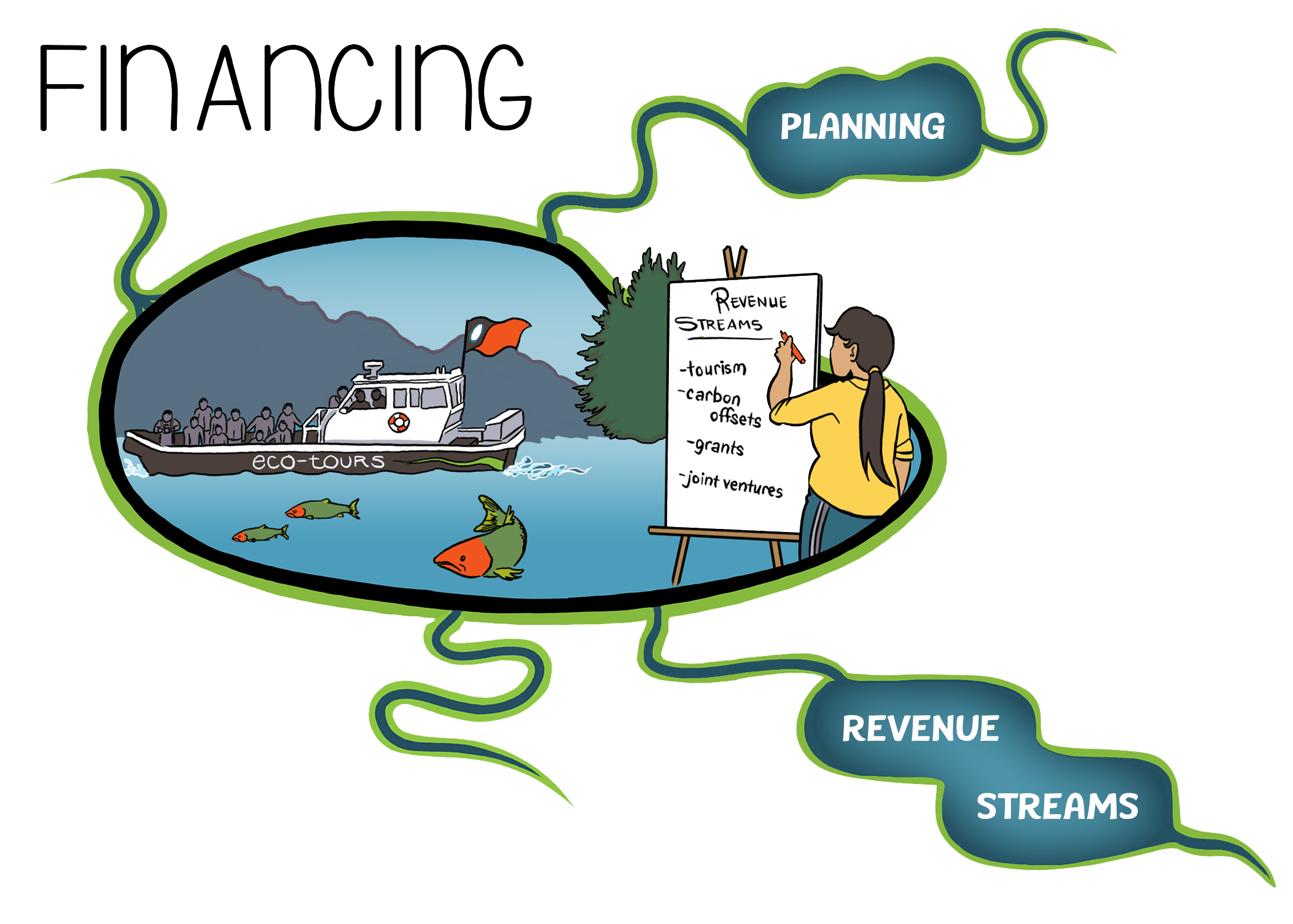
Planning
- What budget do you need to establish and manage your IPCA (i.e. for establishment and operating costs)?
- Tip: Consider roles, functions, and infrastructure to help determine salaries and fees, training needs, coordination costs, legal and business fees, studies, communications costs, and capital investments.
- Tip: Consider costs associated with establishing and managing partnerships and fundraising.
Revenue Streams
- Private/philanthropic funding
- Example: Funders and non-profit partners (NGOs) may provide charitable donations (E.g. land, in-kind and financial support) or grants and support with fundraising, private land acquisition, land trust establishment, and support buying out forestry and mineral tenures, etc.).
- Tip: To receive funding from a charitable foundation it may be necessary to be registered as a charity. Non-profit organizations are different from charities. See the Government of Canada’s definition here.
- Tip: NGOs can provide support to get funding for IPCAs. This includes channeling funding through their organisation if you do not have a charity number. NGOs can also provide strategic, technical and scientific support.
- Example: Funders and non-profit partners (NGOs) may provide charitable donations (E.g. land, in-kind and financial support) or grants and support with fundraising, private land acquisition, land trust establishment, and support buying out forestry and mineral tenures, etc.).
- Federal, provincial, or territorial government funding
- Example: Canada Nature Fund’s Target 1 Challenge (Environment and Climate Change Canada)
- Example: Climate Action and Awareness Fund (Government of Canada)
- Example: The Natural Heritage Conservation Program (Environment and Climate Change Canada)
- Example: Aboriginal Fund for Species at Risk (Environment and Climate Change Canada and Fisheries and Oceans Canada)
- Example: Additional examples are included on pages 16-19 of this report
- Trust and endowment funds
- This type of fund generally includes an initial investment (e.g. through fundraising and private donors, Crown contributions, or own-source revenue). The income is invested by a fund manager and generates income. Typically, the organization receives the investment income while the principal (the main amount of money) is reinvested to keep growing.
- Example: Lutsel K’e Dene First Nation (LKDFN, NWT) established the Thaidene Nëné Fund to fund management and operations. The federal government matched the $15 million raised by Nature United and LKDFN (total $30 million). LKDFN manages the fund and only spends annual interest and investment income to care for Thaidene Nëné.
- Example: Coast Funds is a $118 million investment by private foundations, the Province of B.C. and the Government of Canada that supports Coastal First Nations throughout the Great Bear Rainforest and Haida Gwaii in B.C.
- Example: Walpole Island First Nation (ON) established the Walpole Island Land Trust. The trust has certificates of possession for the Nation’s lands and owns and leases private lands.
- Example: Unama’ki Institute of Natural Resources (NS) purchased land for an IPCA with support from the province and the Canada Nature Fund, which will be held in trust. For more information, see this blog post.
- This type of fund generally includes an initial investment (e.g. through fundraising and private donors, Crown contributions, or own-source revenue). The income is invested by a fund manager and generates income. Typically, the organization receives the investment income while the principal (the main amount of money) is reinvested to keep growing.
- Own source revenue
- Development projects and joint ventures
- Example: Tla-o-qui-aht Nation (B.C.) is a majority owner in Canoe Creek Hydro, a run-of-river hydro project that generates renewable electricity, local jobs, and revenue for the Nation.
- Carbon offsets
- Example: Coastal First Nations Great Bear Initiative, in partnership with the Province of B.C., operates one of the largest carbon offset projects of its kind. Funds contribute to Coastal First Nations’ conservation initiatives.
- Ecosystem services fees
- Example: Through its Tribal Parks Allies program, Tla-o-qui-aht Nation operates a voluntary ecosystems services fee fund. To be certified by Tribal Parks Allies, businesses operating in Tla-o-qui-aht territory agree to give 1 percent of their profits to Tribal Parks Allies which in turn supports Tla-o-qui-aht Nation’s four tribal parks.
- Tourism
- Example: Kitasoo/Xai’xais Nation (B.C.) owns and operates the Spirit Bear Lodge in Klemtu, in the Great Bear Rainforest. Proceeds support conservation including the Kitasoo/Xai’xais Stewardship Authority.
- Development projects and joint ventures
Governance
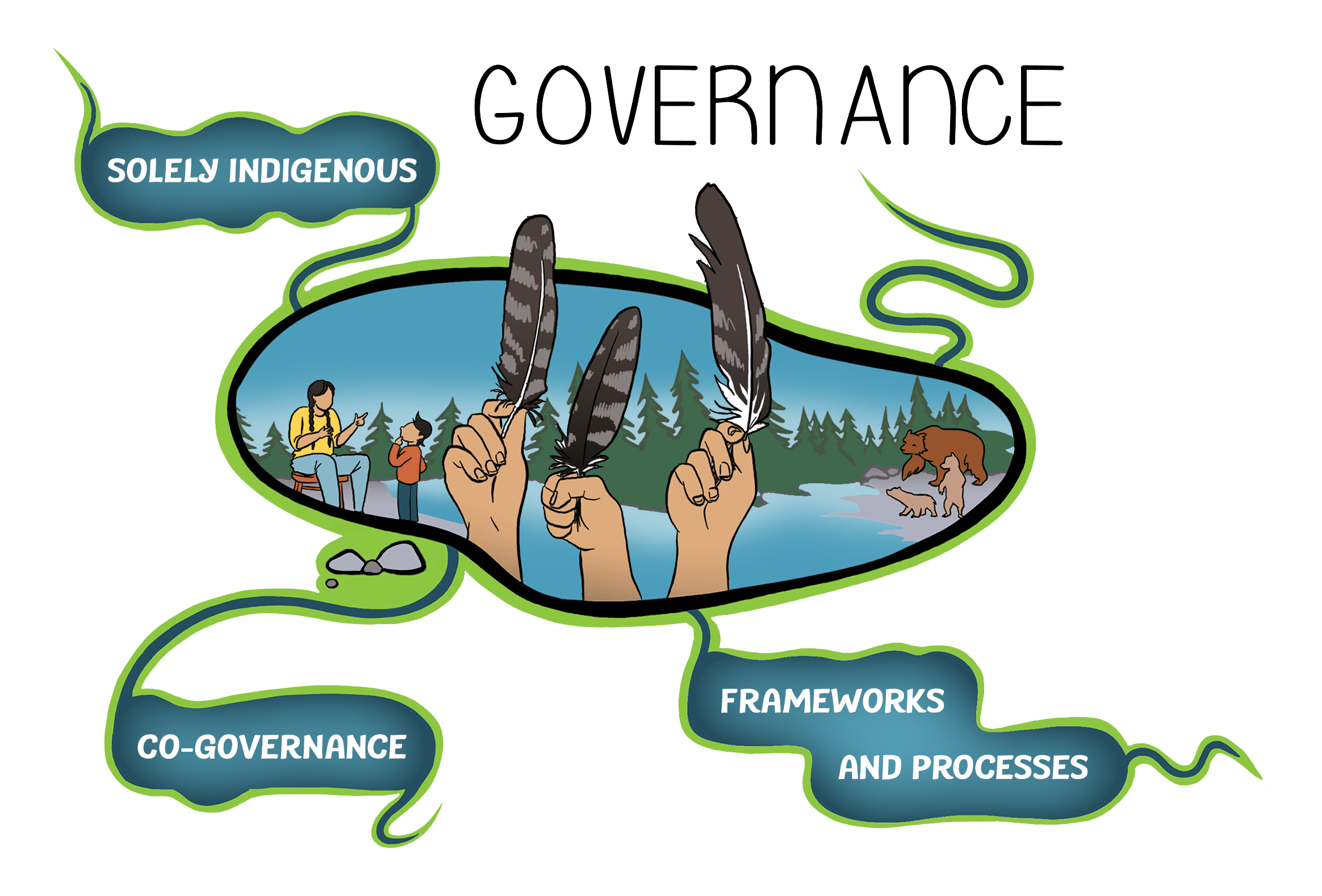
- Who will make decisions about the operations and management of the IPCA?
- How will Indigenous governance systems inform how you establish and care for your IPCA? (E.g. Band Council governments and hereditary leaders/traditional governance systems)
- How will Indigenous authority and leadership be upheld in partnerships with external organizations?
Solely Indigenous
- Indigenous Nation(s), based on rights for self-governance
- Example: Some Indigenous governments oversee their IPCAs as an initiative of Chief and Council with the support of staff and consultants (e.g. Dasiqox Nexwagwez?an Tribal Park, Tla-o-qui-aht Tribal Parks).
- Resource: Tla-o-qui-aht Tribal Parks Governance webinar.
- Example: The Assembly of Nova Scotia Mi’kmaw Chiefs is leading the Sespite’tmnej Kmitkinu Conservancy (Mi’kmaw IPCA initiative, NS). Four Mi’kmaw organizations are coordinating the initiative.
Co-governance
- Co-governance with the Crown, based on agreements
- Some IPCAs have established boards with appointees who have a mandate to implement management and operational directives.
- Example: Lutsel K’e Dene First Nation (LKDFN) negotiated establishment agreements with Parks Canada and the Government of the NWT that set out the terms of Thaidene Nëné’s establishment and the role of each party. Thaidene Nëné Xá Dá Yáłtı is the board responsible for guiding the operations and management of Thaidene Nëné (NWT). LKDFN, Parks Canada, and the Government of NWT (the “parties”) have equal representation on the board. The board uses consensus-based decision making to speak on behalf of Thaidene Nëné. The board makes recommendations to the parties.
- Resource: A summary of both agreements and a copy of the agreement with the Government of the NWT are available here.
- Example: Gwaii Haanas Archipelago Management Board is made up of members from the Council of the Haida Nation, Parks Canada, and the Department of Fisheries and Oceans (B.C.). Together, they make joint decisions that fulfil the management plan.
- Resource: The Fort Good Hope Dene Band, Yamoga Land Corporation, Fort Good Hope Metis Nation, Ayoni Keh Land Corporation, and Behdzi Ahda First Nation signed an establishment agreement with the Government of the NWT. The agreement outlines a process for establishing and co-managing Ts’udé Nilįné Tuyeta (NWT).
- Example: Curve Lake First Nation (CLFN, Ontario) established the Kinomaage-Waapkong Advisory Committee to work with the Ministry of Natural Resources and Ontario Parks. The committee ensures the proper management of the sacred site in Petroglyphs Provincial Park (ON). Elders, youth, a Councillor and community members from CLFN (along with government representatives) sit on the committee.
- Example: The Qikiqtani Inuit Association (QIA) and the Government of Canada signed an Inuit Impact Benefit Agreement (2019) to establish the Tallurutiup Imanga National Marine Conservation Area (NMCA) in Lancaster Sound (NU). A board with equal representation of Inuit and Government of Canada representatives will be established. The board will use consensus-based decision making and Inuit Qaujimajatuqangit (Inuit knowledge) to steward the NMCA.
- Example: The Tahltan Central Council (B.C.) used provincial protected area legislation to establish Mt. Edziza Conservancy with the Province of B.C. (2021). Conservancies allow for co-governance First Nations’ social, ceremonial, and cultural uses.
- Some IPCAs have established boards with appointees who have a mandate to implement management and operational directives.
Frameworks and Processes
- Who can help come up with a plan for how decisions about the IPCA will be made? (E.g. leaders, knowledge holders, Elders, lawyers, advisors, etc.)?
- How will decisions be made to uphold the Nation(s) and community(ies) values and objectives for the IPCA?
- How can Indigenous laws and Indigenous/traditional governance contribute to decision-making?
- How could community members, including Elders and youth, be involved in making decisions?
- How could Indigenous Guardians, as “the eyes and ears” on the ground, be involved?
- Example: Some Nations create a management plan or strategy that describes the goals, decision-making processes, timelines, etc.
- Resource: Unama’ki Institute of Natural Resources’ (2020) report “Tan Telolti’k: How we are doing now” initiates management planning and informs a decision-making framework for IPCAs in Unama’ki (NS).
- Resource: Thaidene Nëné: 2020-2025 Strategic Plan
- Resource: Gwaii Haanas Gina ‘Waadluxan KilGuhlGa Land-Sea-People Management Plan (2018)
- Resource: Te Kawa o Te Urewera (Te Urewera, Aotearoa/New Zealand):
- How will conflict be addressed?
- Are there cultural/traditional conflict mediation processes and protocols that can be helpful?
- Example: Thaidene Nëné Xá Dá Yáłtı (management board for Thaidene Nëné) uses consensus-based decision making. If there is a disagreement that cannot be resolved it will go to a mediation process. From there the issue will be referred to the Lutsel K’e Dene First Nation Chief and Minister for a decision.
Partnerships
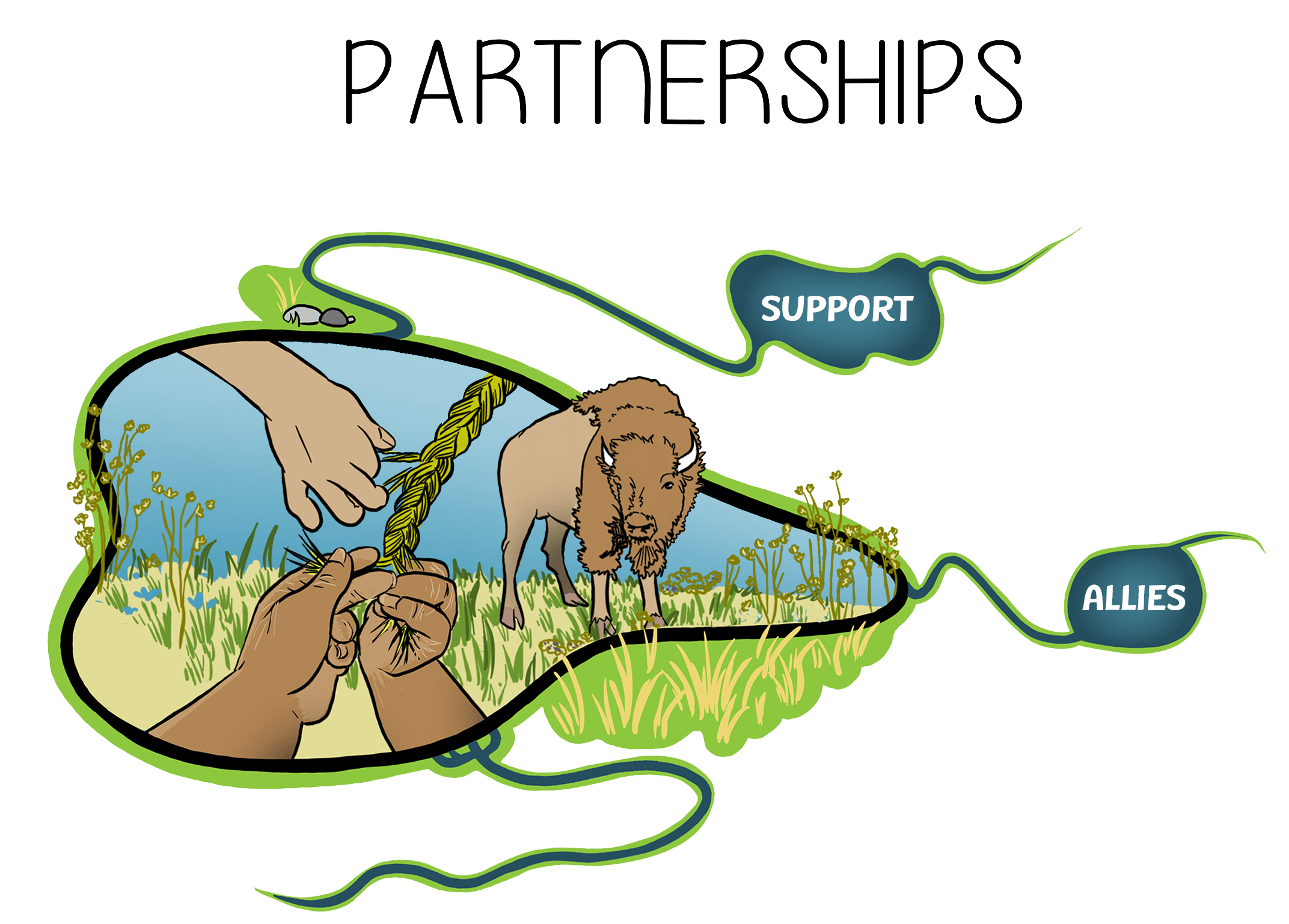
Support
- What kinds of support would be helpful for establishing and caring for your IPCA? (E.g. legal, financial/fundraising, training, operations, monitoring, purchasing land, equipment/infrastructure, stewardship, etc.)
Allies
- Who could be appropriate partners? (E.g. Indigenous Nations and organizations, NGOs, Crown governments and agencies, universities, municipalities, etc.)
- Example: Some Indigenous governments solely govern their IPCAs (e.g. Dasiqox Nexwagwez?an with support from philanthropic organizations, Tla-o-qui-aht Tribal Parks with support from local businesses, or “Tribal Park Allies”) while others have partners with whom they share governance and financing responsibilities (e.g. Thaidene Nëné, Gwaii Haanas).
- Example: The Blackfoot Confederacy (Blackfeet Nation, Kainai Nation, Piikani Nation, and Siksika Nation) launched the Iinnii Initiative to restore and protect sacred relationships with iinnii (buffalo) across the Canada/U.S. border. In 2014, many people signed the Buffalo Treaty which is celebrated and renewed annually. The Oakland Zoo (California) supports the natural breeding of iinnii (bison) to be returned to freely roam Blackfeet tribal land in Montana.
- Example: Muteshekau-shipu Alliance works towards the protection of the Muteshekau shipu (the Magpie River) in Quebec. The Alliance is made up of the Innu First Nation of Ekuanishit, the Minganie Regional County Municipality, SNAP Québec (Québec chapter of CPAWS), and Eaux-Vives Minganie (NGO representing white water sports). In 2021, the Alliance declared the river a legal person with nine rights. Members of the Innu Council of Ekuanitshit will act as the river’s guardians.
- Example: Uapashkuss, an Innu organization (Quebec), and SNAP Québec launched the Pakatakan project for the recognition and protection of Innu natural sacred sites
- Example: Shawanaga First Nation (ON) created the Shawanaga Island IPCA within the Georgian Bay Biosphere Reserve. A variety of partners are supporting the IPCA.
- What avenues exist for increasing understanding and support of the IPCA from neighbouring municipalities, local business owners, and the public?
- Example: Tla-o-qui-aht Nation operates a Tribal Parks Allies program which generates commitments and funding in support of the Tribal Parks
- What avenues exist for increasing understanding and support for the IPCA among federal/provincial/territorial governments and agencies?
- Example: SNAP Québec (NGO), in collaboration with the David Suzuki Foundation and the First Nations of Québec and Labrador Sustainable Development Institute, organised a day-long symposium on IPCAs (Québec). First Nations presented their IPCA projects to Québec and Federal government representatives.
Operations and Stewardship
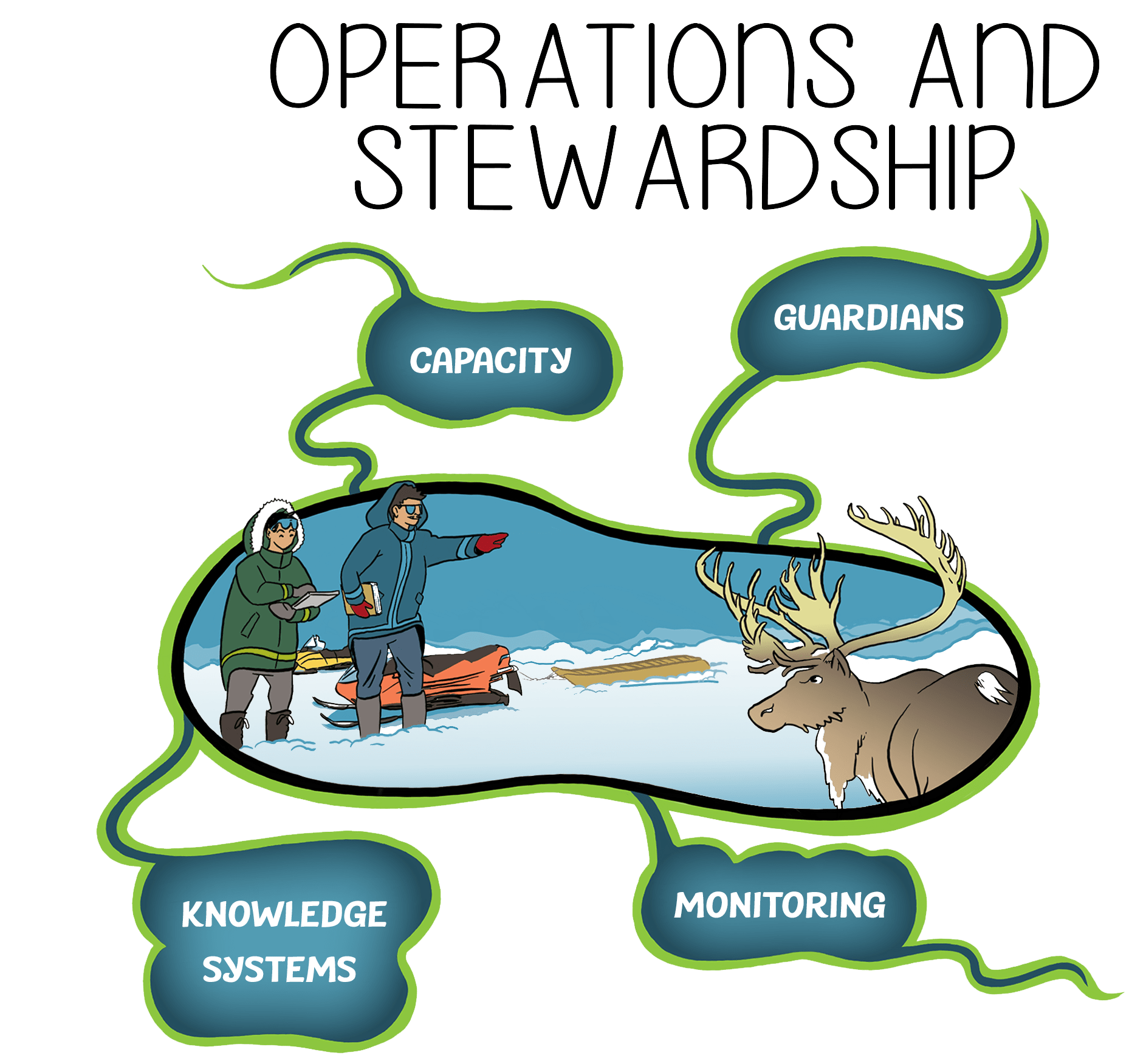
Capacity
- What skills or capacity gaps need to be addressed to support leadership and staff to take on this work?
- Who could share knowledge, or help train people, to build this capacity?
- Will new positions need to be created (e.g. Board Chair, IPCA Manager, Advisor, Liaison, Community Coordinator, etc.)?
- How could the IPCA support inter-generational knowledge sharing?
Guardians
- How could Indigenous Guardians support the establishment and ongoing care for the IPCA?
- Resource: Indigenous Guardians Toolkit
- Resource: Indigenous Guardians Pilot (Government of Canada initiative and funding)
- Resource: Indigenous Leadership Initiative
- Resource: Land Needs Guardians
Knowledge Systems
- What types of knowledge will inform how you establish, or interact with, your IPCA? (E.g. oral history, cultural teachings, data, reports, etc.)
- Example: Dena Tha’ First Nation is using traditional knowledge and Western science in its environmental and caribou monitoring programs in Bistcho Lake IPCA (AB).
- Example: Two-eyed seeing approach that draws on the gifts of Indigenous knowledge and Western sciences.
- In what types of activities or processes can different knowledge systems be applied? (E.g. Naming/language, hiring, management directions, communications and reporting, etc.)
- How could Indigenous language/s be strengthened through your IPCA?
Monitoring
- How could you measure progress towards your conservation and protection objectives?
- Example: Miawpukek First Nation Guardians (NL) are monitoring various harvesting activities.
- Example: Dena Tha’ First Nation (AB) designed a mobile app they use to record Indigenous and Western scientific knowledge in Bistcho Lake IPCA. Relying on Indigenous Knowledge of caribou, the Nation set up a network of wildlife cameras to monitor caribou and other wildlife.
Communication and Relationships
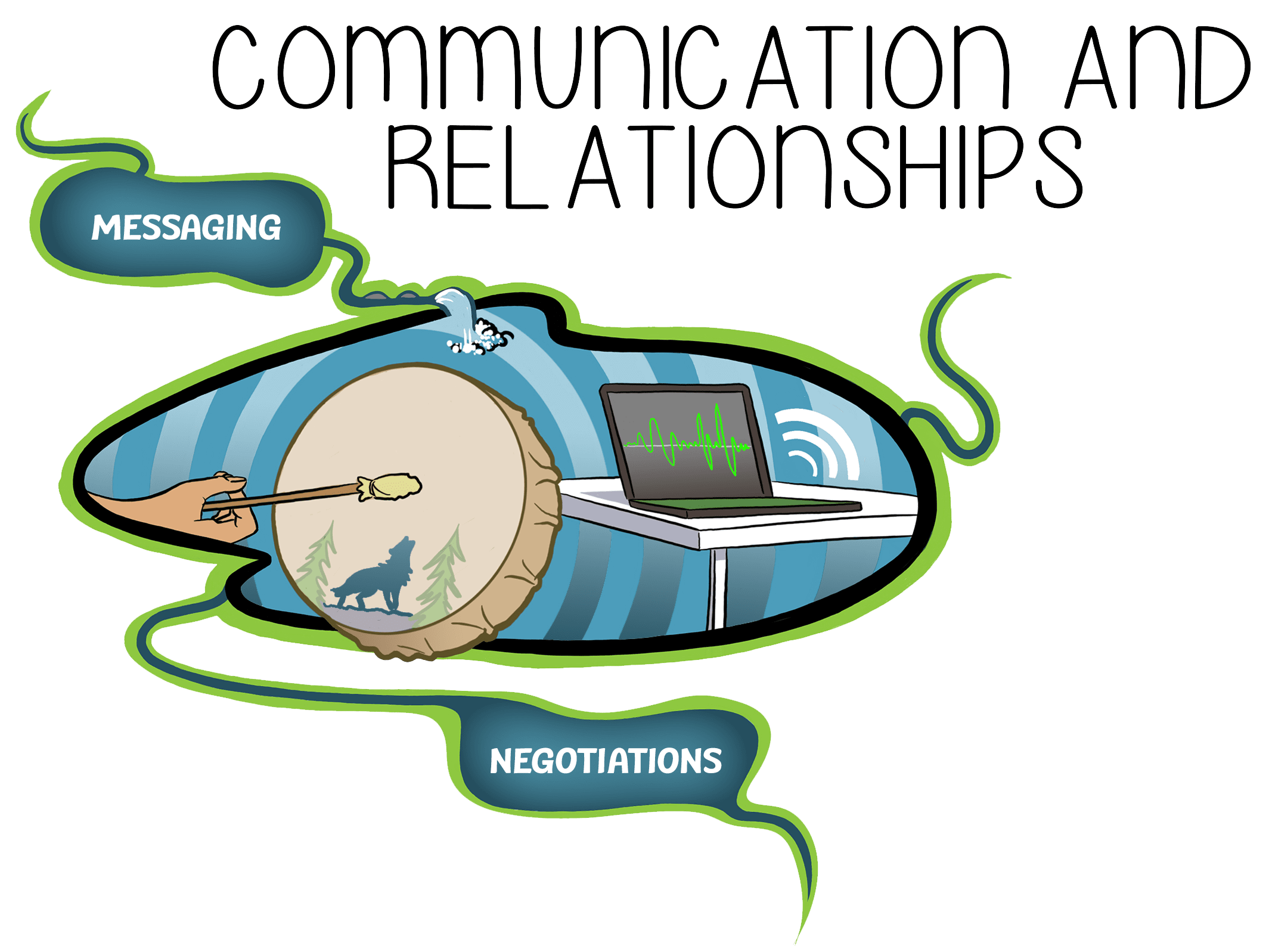
Messaging
- How can the IPCA vision and plans be communicated internally (at the community and Nation level) and externally (neighbouring Indigenous Nations, Crown governments, stakeholders, public) to gain support?
- Example: Dena Kayeh Institute (Kaska Dena Council) developed fact sheets and a brochure to share their vision for Dene Kʼéh Kusān: https://kaskadenacouncil.com/dene-k-eh-kusan/
- Example: Some Nations create short videos describing their initiatives and visions:
- Algonquin Aki Sibi Project (Algonquin Nation, ON) https://www.youtube.com/watch?v=HD0eEairDXw
- Arqvilliit IPCA (Inuit, Nunavik) https://www.youtube.com/watch?v=Dr7kH7khHuE
- Dasiqox Tribal Park (Xeni Gwet’in First Nation, Yunesit’in Government, Tŝilhqot’in National Government, B.C.) https://www.youtube.com/watch?v=DoIyIj0UYIs&t=2s
- Sakitawak IPCA (Métis, SK) https://www.youtube.com/watch?v=TFPcCOaIzoY
- Tla-o-qui-aht Tribal Parks (Tla-o-qui-aht Nation, B.C.) https://www.youtube.com/watch?time_continue=13&v=VUf18L-i_HY&feature=emb_logo
- Some Nations enter into agreements with neighbouring Nations
- Example: Mutual Cooperation Protocol (KI, Wapekeka and Grassy Narrows First Nations, ON) https://www.netnewsledger.com/2020/01/23/kitchenuhmaykoosib-lnninuwug-wapekeka-and-grassy-narrows-sign-mutual-co-operation-protocol/
- How can you make a strong case for the IPCA if you’re looking for partners and external support?
- Tip: What benefits will the IPCA provide locally, nationally, and globally (E.g. cultural, environmental, economic, health and well-being, etc.).
- Tip: What information can you share about protection efforts, management approaches, and resources required? (E.g. ecological goods and services, sustainable economic frameworks, proposed management plans, etc.)
- Tip: What reports or evidence would strengthen your case?
Negotiations
- Does it make sense to coordinate communications with ongoing or potential negotiations with Crown governments or industry?
Designing for Success
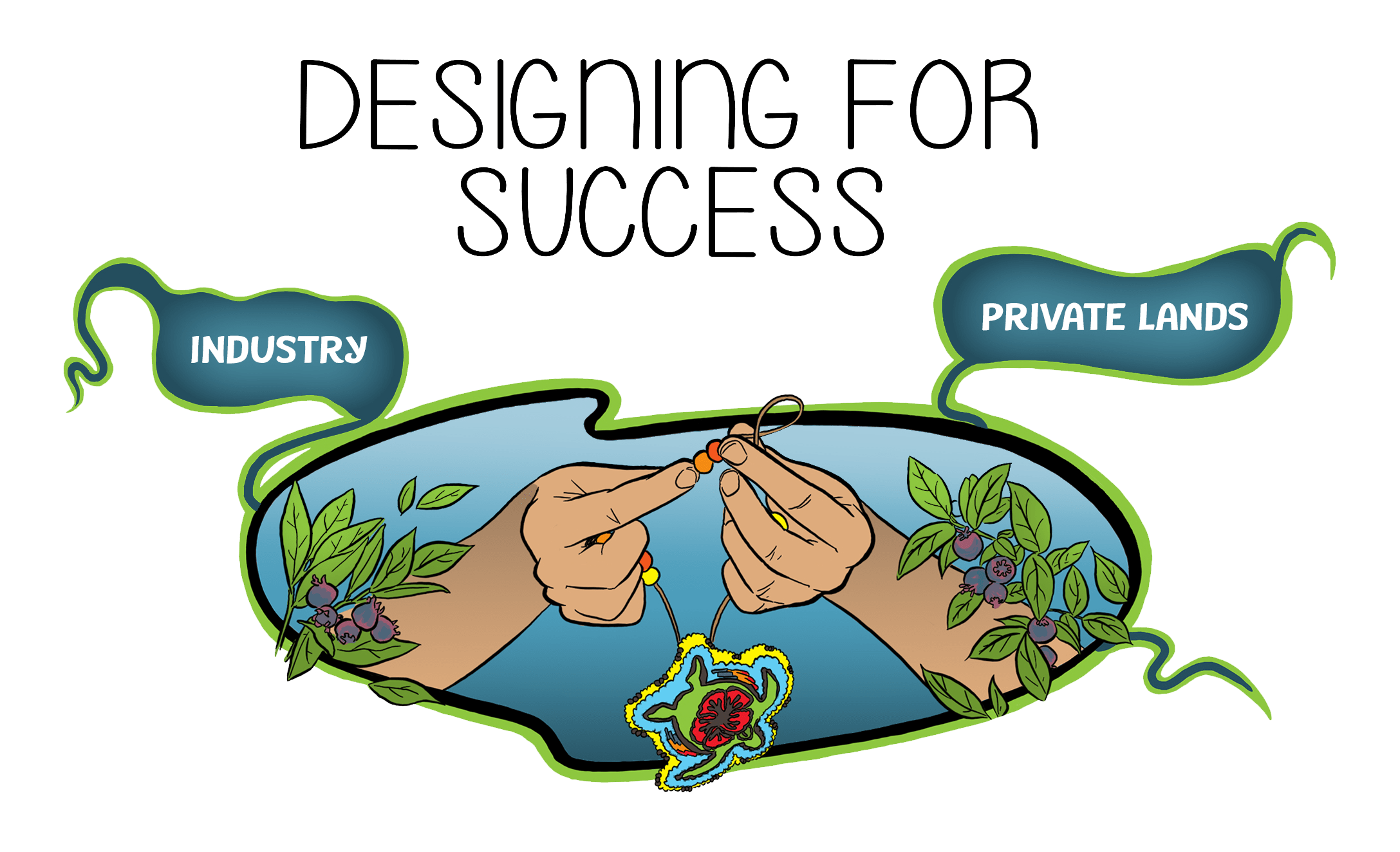
Industry
- How will tenures held by external companies (e.g. mining, forestry, commercial fishing, development) be addressed if they threaten the viability of the IPCA?
- Example: Ktunaxa Nation Council worked with the Nature Conservancy of Canada (NCC) to buy out the development tenures that threatened the establishment of Qat’muk Tribal Park (B.C.). Funding was provided by NCC, Environment and Climate Change Canada (Challenge Funds), and philanthropic sources.
- Example: In Thaidene Nëné key areas threatened by mining received interim protection under significant “land withdrawals” in 1970 and 2007 which stopped mining while negotiations were underway. Parks Canada enacted the first withdrawal and the second one was negotiated through the Akaitcho Process.
Private Lands
- If applicable, how can the issue of private land ownership for or in the IPCA be addressed?
- Example: The W̱SÁNEĆ Leadership Council (B.C.) worked with The Land Conservancy of B.C. who bought and then transferred SISȻENEM (Halibut Island) to the Nation. W̱SÁNEĆ Leadership Council now officially stewards SISȻENEM, an important cultural place.
- Example: The Mi’kmaw-led land trust Sespite’tmnej Kmitkinu Conservancy purchased lands that will enable it to protect a sacred site, Kluskap Cave. https://www.cbc.ca/news/canada/nova-scotia/first-nations-conserve-land-1.6027074
- Example: The Chippewas of Nawash (ON) and Ontario Heritage Trust (a provincial agency) worked together to purchase Nochemowenaing. In 2011, both groups signed a co-management agreement that outlines shared responsibility to this sacred place.
- Example: Walpole Island First Nation (ON) established the Walpole Island Land Trust in 2008. Through the land trust the Nation partners with other organizations to purchase or assume care for lands and waters that the Nation then protects.

